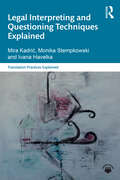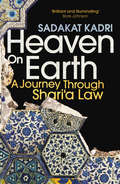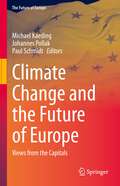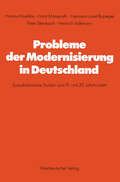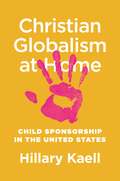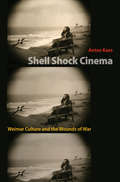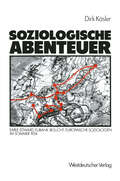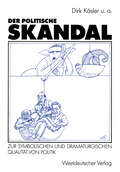- Table View
- List View
Legal Interpreting and Questioning Techniques Explained (Translation Practices Explained)
by Mira Kadrić Monika Stempkowski Ivana HavelkaLanguage and law are closely linked, and language is fundamental to the application of the law. Legal, criminalistic, translational and psychological aspects of communication come together in interpreted questioning (hearings, interrogations, interviews) and must be taken into account, especially since the way in which the questioning outcomes are evaluated can have far-reaching legal consequences. Building on empirical studies and practice, this accessible text provides a transdisciplinary examination of questioning methods and strategies. The institutional framework conditions of a questioning situation are examined in the context of transdisciplinary cooperation.This book also addresses the increasing use of technology and hybrid forms of translation and interpreting in the legal system, and shows different ways in which interpreters co-construct information. Chapters include summaries of key concepts and definitions, examples from existing literature combined with practical experience and the results of surveys conducted by the authors, as well as further reading and non-language-specific study activities. Activities include role plays on thematic scenarios involving different actors in criminal proceedings and discussion groups to enable reflection on ethical issues and discursive challenges.This is a vital text for both advanced students and professionals in interpreting studies and criminology.
Heaven on Earth: A Journey Through Shari‘a Law
by Sadakat KadriThis book is important because it is:Unique. Heaven on Earth offers a critique of extremism that is human rights-based and entertaining – combining the comparative approach of Karen Armstrong and the immediacy of Ed Husain (The Islamist) with storytelling. Timely. At a time of veil bans, Qur’an burnings and English Defence League protests, Kadri voices a liberal view of Islamic history and shows Muslims working against repression. This book explains up-to-the-minute brutalities.Epic. Interviews, anecdotes, personal reflection and analysis are set against a narrative that sweeps from seventh-century Mecca to the war in Afghanistan. Civilisations are evoked via the vivid lives of caliphs, mystics, and travellers. Legal changes are described through the feuds, courtroom dramas, conquests and cataclysms that have left their mark on modern Islamic law. First-hand. On the road for five months, Kadri travelled through Iran just before the June 2009 election protests, and took part in a human rights conference there with ayatollahs and academics. Eye-opening. This book goes beyond the explosive headline issues (criminal justice, women, jihad, religious freedom) to reveal the stranger ones: genie exorcisms; the legal consequences of premature ejaculation; online fatwa advice; the sharia approach to Facebook and Qur’anic mobile phone ringtones, etc.Bold. Heaven on Earth primarily targets religious extremism, but also cuts anti-Muslim panic down to size.
Recent Trends in Social and Behaviour Sciences: Proceedings of the International Congress on Interdisciplinary Behaviour and Social Sciences 2013
by Seifedine Kadry Pak Shen Li Marie Taylor Ford Lumban GaolThe human aspect plays an important role in the social sciences. The behaviour of people has become a vital area of focus in the social sciences as well. Recent Trends in Social and Behaviour Sciences contains papers that were originally presented at the International Congress on Interdisciplinary Behavior and Social Sciences, held 4-5 November 201
Sozialpartnerschaft und Industriepolitik: Strukturwandel im Organisationsbereich der IG Chemie-Papier-Keramik (Schriften des Zentralinstituts für sozialwiss. Forschung der FU Berlin #78)
by Jürgen Kädtler Hans-Hermann HertleDie Studie analysiert den Wandel der Organisation und der Politik der IG Chemie-Papier-Keramik seit den siebziger Jahren. Als Leitimpulse dieses Wandels gelten das Auslaufen des Wachstums-Vollbeschäftigungs-Automatismus der bundesdeutschen Wirtschaftswundergesellschaft, die Politisierung industrieller Produktion durch eine gesellschaftlich breitenwirksame Ökologiekritik und die mit der Entwicklung zur Angestelltengesellschaft verbundenen gewerkschaftlichen Rekrutierungsprobleme. Die Aufnahme und Verarbeitung dieser Probleme durch die IG Chemie-Papier-Keramik erfolgt im Sinne einer branchenzentrierten Industriepolitik, die auf branchenwirtschaftliche Kooperation anstelle konflikthafter Interessendurchsetzung als zentrales Vertretungsmittel setzt. Diese Politik bildet eine Variante einer allgemeinen Tendenz, die branchenübergreifenden gewerkschaftspolitischen Positionen dauerhaft die Substanz entzieht.
Betriebsräte in Ostdeutschland: Institutionenbildung und Handlungskonstellationen 1989–1994 (Schriften des Zentralinstituts für sozialwiss. Forschung der FU Berlin)
by Jürgen Kädtler Gisela Kottwitz Rainer WeinertGegenstand der Untersuchung ist die Neuordnung betrieblicher Interessenstrukturen in Ostdeutschland von 1989 bis 1993. Die Entstehung von Betriebsräten wird handlungstheoretisch als Institutionenbildung gefaßt. Ziel der Arbeit ist die Analyse allgemeiner betrieblicher Problem- und Handlungskonstellationen (Personalabbau, Sozialplanpolitik, Umsetzung der Tarifverträge, Betriebsräte und Arbeitskampf, Betriebsräte und Gewerkschaften). Die empirische Basis bilden 21 ursprünglich großindustrielle Betriebe in Thüringen, Sachsen und im ehemaligen Ostberlin, die zu DDR-Zeiten bereits bestanden. Auf dieser Grundlage werden allgemeine Entwicklungstrends ostdeutscher Betriebsräte als Bestandteil des Systems industrieller Beziehungen aufgezeigt. Eine Bilanz nach der ersten gesamtdeutschen Betriebsratswahl im Frühjahr 1994 kommt zu dem Ergebnis, daß sich aus den Impulsen des ostdeutschen betrieblichen Neuanfangs Ende 1989 und dem Transfer westdeutscher Institutionen eine durchaus eigenständige Variante des dualen Vertretungssystems entwickelt hat, die nicht nur vorübergehend Bestand haben wird.
The American Intellectual Elite
by Charles KadushinThere are almost as many works about intellectuals as there are intellectuals. Perhaps this is because intellectuals are masters of the word and their mastery is often used to write about themselves. Indeed, with the possible exceptions of sports figures and film actors, intellectuals may be the most overpublicized people in America. In this classic study, originally published in 1974, Charles Kadushin examines the attitudes of that class of people known as the American intellectual elite.While most works on intellectuals first establish who should be included under the title "intellectual," and debate their characteristics, Kadushin instead sets forth a sociological history of leading American intellectuals of the late 1960s. The book's concern, however, is primarily with time and place. While The American Intellectual Elite is very much about social circles and the networked "small world" of intellectuals defined by the institutions such as the journals and magazines around which they gathered, the uniqueness of this volume is the recognition that fact must come before theory. Thus, the collective attitude of leading intellectuals of the sixties are presented in a straightforward and dispassionate manner on topics as diverse as the Vietnam War, race relations, foreign and domestic policy, and the place of intellectuals in the resolution of such issues.Now in paperback with a new introduction by the author, The American Intellectual Elite is an influential work that will be valued by students of sociology, members of the intellectual elite, and professionals and students of contemporary American history.
Understanding Social Networks: Theories, Concepts, and Findings
by Charles KadushinDespite the swift spread of social network concepts and their applications and the rising use of network analysis in social science, there is no book that provides a thorough general introduction for the serious reader. Understanding Social Networks fills that gap by explaining the big ideas that underlie the social network phenomenon. Written for those interested in this fast moving area but who are not mathematically inclined, it covers fundamental concepts, then discusses networks and their core themes in increasing order of complexity. Kadushin demystifies the concepts, theories, and findings developed by network experts. He selects material that serves as basic building blocks and examples of best practices that will allow the reader to understand and evaluate new developments as they emerge. Understanding Social Networks will be useful to social scientists who encounter social network research in their reading, students new to the network field, as well as managers, marketers, and others who constantly encounter social networks in their work.
Understanding Social Networks: Theories, Concepts, and Findings
by Charles KadushinDespite the swift spread of social network concepts and their applications and the rising use of network analysis in social science, there is no book that provides a thorough general introduction for the serious reader. Understanding Social Networks fills that gap by explaining the big ideas that underlie the social network phenomenon. Written for those interested in this fast moving area but who are not mathematically inclined, it covers fundamental concepts, then discusses networks and their core themes in increasing order of complexity. Kadushin demystifies the concepts, theories, and findings developed by network experts. He selects material that serves as basic building blocks and examples of best practices that will allow the reader to understand and evaluate new developments as they emerge. Understanding Social Networks will be useful to social scientists who encounter social network research in their reading, students new to the network field, as well as managers, marketers, and others who constantly encounter social networks in their work.
Arbeitsschutz in der Berufsausbildung: Chancen und Wettbewerbsvorteile
by Astrid KaedingArbeitsschutz hat in der modernen Berufsausbildung eine andere Position inne als noch vor wenigen Jahren. Ursächlich dafür sind nicht nur neue Berufsbilder und gesetzliche Forderungen, auch Betriebe und Einrichtungen nutzen bereits bewusst das Potenzial des Wettbewerbsvorteils von Arbeitsschutz und tragen somit an ihre Jugendlichen von Anfang an ein anderes Selbstverständnis heran. Die AutorInnen wollen dieses Vorgehen nicht nur unterstützen, sondern zu mehr Aktivität in dieser Hinsicht ermuntern. Der Präventionsgedanke gilt jedoch für alle potenziellen ArbeitnehmerInnen, auch für benachteiligte Jugendliche oder AbsolventInnen eines höherwertigen Abschlusses. Das Buch wendet sich an Dozierende und Studierende der Sozialen Arbeit und der Wirtschaftswissenschaften sowie an betriebliche AusbilderInnen und BerufsschullehrerInnen.
Climate Change and the Future of Europe: Views from the Capitals (The Future of Europe)
by Michael Kaeding Johannes Pollak Paul SchmidtWhile the ambitious objectives outlined in the EU’s Green Deal aim at making Europe the first climate-neutral continent by 2050, national implementation greatly varies depending on local geographies, history, culture, economics, and politics. This book analyses Member States’ and EU neighbours’ national efforts to combat climate change. It subsequently draws on these factors to highlight local challenges, tensions, and opportunities on the road towards climate neutrality. In the context of inter-country dependencies following Russia’s war against Ukraine, it addresses strategic questions regarding EU integration, the transformation of our economies, the reduction of energy dependencies, and public perception of the above. The book also makes concrete recommendations, in various policy areas, on how individual countries and the EU as a whole should deal with the climate crisis.
Führen als Beruf: Andere erfolgreich machen
by Boris KaehlerFür Führungskräfte ist Führen eine berufliche Tätigkeit. Allerdings haben die wenigsten eine sehr konkrete Vorstellung davon. Dieses Buch entwirft mit den drei Teilen Führungsverständnis, Führungsalltag und Führungsstrategie ein umfassendes professionelles Selbstverständnis. Es geht darum, ein realistisches und funktionales Managementbild jenseits von Klischees und Modekonzepten zu vermitteln. Dabei steht die praktische Umsetzbarkeit im Vordergrund: Was genau ist zu tun? Worauf kommt es in der Praxis an?Theoretische Grundlage dafür ist das Modell der Komplementären Führung. Führungskräfte wirken im Wesentlichen durch andere, nämlich ihre Mitarbeiterinnen und Mitarbeiter. Sie sollten dabei primär auf deren Selbststeuerung setzen, aber im Bedarfsfall kompensierend eingreifen. Bezugspunkt dafür sind die vielfältigen Aufgabenstellungen, Aktivitäten und Instrumente ganzheitlicher Personalführung, die das Modell zu einem Gesamtkonzept integriert. Allgemeinverständlich und mit zahlreichen Praxistipps, das Werk richtet sich an alle, die Führen als Arbeit verstehen und sich zum Ziel gesetzt haben, ihre Organisationseinheit und deren Mitglieder erfolgreich zu machen.
Der Boom 1948–1973: Gesellschaftliche und wirtschaftliche Folgen in der Bundesrepublik Deutschland und in Europa (Schriften des Zentralinstituts für sozialwiss. Forschung der FU Berlin #64)
by Hartmut KaelbleProbleme der Modernisierung in Deutschland: Sozialhistorische Studien zum 19. und 20. Jahrhundert (Schriften des Zentralinstituts für sozialwiss. Forschung der FU Berlin #27)
by Hartmut KaelbleThe Rich and the Poor in Modern Europe, 1890-2020: A Historian’s Response to Recent Debates among Economists
by Hartmut KaelbleAs social inequality grows, historical analysis on wealth and income distribution across the 20th century often does not take into account inequality of education, health, housing and chances of social mobility, nor does it differentiate statistical inequality from the realities of peoples’ actualexperience. With this broad understanding in mind, in a long look back on the history of social inequality in Europe, The Rich and the Poor in Modern Europe addresses these neglected subjects. It also tackles the commonplace notion that modern capitalism inevitably produces wealth gaps and asks whether the facts and figures we possess also lead to alternate interpretations of examples of mitigated inequality. Covering the 20th century and the beginnings of the 21st century in Europe through wars, and economic crises, through periods of unprecedented economic prosperity and staggering economies, both exacerbating and dampening the problem, acclaimed historian Hartmut Kaelble offers a rigorous response to understanding our present-day challenge of social inequality.
The Rich and the Poor in Modern Europe, 1890-2020: A Historian’s Response to Recent Debates among Economists
by Hartmut KaelbleAs social inequality grows, historical analysis on wealth and income distribution across the 20th century often does not take into account inequality of education, health, housing and chances of social mobility, nor does it differentiate statistical inequality from the realities of peoples’ actualexperience. With this broad understanding in mind, in a long look back on the history of social inequality in Europe, The Rich and the Poor in Modern Europe addresses these neglected subjects. It also tackles the commonplace notion that modern capitalism inevitably produces wealth gaps and asks whether the facts and figures we possess also lead to alternate interpretations of examples of mitigated inequality. Covering the 20th century and the beginnings of the 21st century in Europe through wars, and economic crises, through periods of unprecedented economic prosperity and staggering economies, both exacerbating and dampening the problem, acclaimed historian Hartmut Kaelble offers a rigorous response to understanding our present-day challenge of social inequality.
A Social History of Europe, 1945-2000: Recovery and Transformation after Two World Wars (Berghahn Ser.)
by Hartmut KaelbleSince 1945 Europe has experienced many periods of turmoil and conflict and as many moments of peace and integration: from the devastation felt in the aftermath of World War II to the recovery in the 1950s and 1960s; to the new challenges in the 1970s and 1980s when neoliberal policies led to fundamental social and economic changes, marked by the effects of the oil shock and widespread unemployment; and then 1989 and after when the existing world order experienced new convulsions. In this brilliant and comprehensive work, the author, one of the best known social historians of Europe, discusses a wide range of subjects, not shying away from controversial topics: family structure, work, consumption, values, migration, inequality, elites, civil society, social movements, media, welfare state, education, and urban policies. He focuses on the fundamental changes European societies underwent in the second half of the twentieth century but also explores what divides Europeans, what unites them, and what sets them apart from the rest of the world. This major historical work will be an important and highly sought-after addition for library collections as well as an important volume for course adoptions.
Bubbles & Bodies - Neue Öffentlichkeiten zwischen sozialen Medien und Straßenprotesten: Interdisziplinäre Erkundungen (Edition Kulturwissenschaft #218)
by Lukas Kaelin Andreas Telser Ilaria Hoppe»Öffentlichkeit« ist umstritten und umkämpft und sie scheint einem beschleunigten Wandel zu unterliegen. Soziale Medien bieten in Echtzeit jedem die Möglichkeit zur politischen Teilhabe. »Verkörperte« Versammlungen fordern verstärkt die Politik heraus, doch ohne die virtuellen »Bubbles« und die materiellen »Bodies« ist die gegenwärtige Öffentlichkeit nicht mehr zu denken. Die Beiträger*innen des Bandes thematisieren unterschiedliche Aspekte dieser neuen Öffentlichkeit und untersuchen besonders die Relevanz von Körpern, Bildern und hybriden Medien sowie deren ökonomische Bedingungen. Mit Perspektiven aus der Philosophie, der Theologie und der Kultur- und Kunstwissenschaft geht es um eine Neubestimmung gegenwärtiger Öffentlichkeit.
Christian Globalism at Home: Child Sponsorship in the United States
by Christian Global Hillary KaellAn exploration of how ordinary U.S. Christians create global connections through the multibillion-dollar child sponsorship industryChild sponsorship emerged from nineteenth-century Protestant missions to become one of today’s most profitable private fund-raising tools in organizations including World Vision, Compassion International, and ChildFund. Investigating two centuries of sponsorship and its related practices in American living rooms, churches, and shopping malls, Christian Globalism at Home reveals the myriad ways that Christians who don’t travel outside of the United States cultivate global sensibilities.Kaell traces the movement of money, letters, and images, along with a wide array of sponsorship’s lesser-known embodied and aesthetic techniques, such as playacting, hymn singing, eating, and fasting. She shows how, through this process, U.S. Christians attempt to hone globalism of a particular sort by oscillating between the sensory experiences of a God’s eye view and the intimacy of human relatedness. These global aspirations are buoyed by grand hopes and subject to intractable limitations, since they so often rely on the inequities they claim to redress.Based on extensive interviews, archival research, and fieldwork, Christian Globalism at Home explores how U.S. Christians imagine and experience the world without ever leaving home.
Christian Globalism at Home: Child Sponsorship in the United States
by Christian Global Hillary KaellAn exploration of how ordinary U.S. Christians create global connections through the multibillion-dollar child sponsorship industryChild sponsorship emerged from nineteenth-century Protestant missions to become one of today’s most profitable private fund-raising tools in organizations including World Vision, Compassion International, and ChildFund. Investigating two centuries of sponsorship and its related practices in American living rooms, churches, and shopping malls, Christian Globalism at Home reveals the myriad ways that Christians who don’t travel outside of the United States cultivate global sensibilities.Kaell traces the movement of money, letters, and images, along with a wide array of sponsorship’s lesser-known embodied and aesthetic techniques, such as playacting, hymn singing, eating, and fasting. She shows how, through this process, U.S. Christians attempt to hone globalism of a particular sort by oscillating between the sensory experiences of a God’s eye view and the intimacy of human relatedness. These global aspirations are buoyed by grand hopes and subject to intractable limitations, since they so often rely on the inequities they claim to redress.Based on extensive interviews, archival research, and fieldwork, Christian Globalism at Home explores how U.S. Christians imagine and experience the world without ever leaving home.
Smartphones als digitale Nahkörpertechnologien: Zur Kybernetisierung des Alltags (Digitale Gesellschaft #21)
by Timo KaerleinMenschen, die auf Displays starren. - Das Smartphone ist binnen kürzester Zeit zu einem unentbehrlichen Medium des Selbst- und Weltbezugs für viele Menschen geworden. Alltägliche Szenen des nicht-bewussten, weitgehend habitualisierten Gebrauchs künden hiervon. Timo Kaerlein unternimmt die Beschreibung, Historisierung und Kritik dieses Komplexes nahkörperlicher Computernutzung, der seit ca. Mitte der 2000er Jahre mit der ubiquitären Verbreitung des Smartphones aufkam. Die medienanthropologische Perspektive beleuchtet neue Aspekte des vermeintlich vertrauten Objekts - darunter etwa die häufig der Sichtbarkeit entzogenen Kontrollinfrastrukturen dieser personalisierten Überwachungstechnologie.
Shell Shock Cinema: Weimar Culture and the Wounds of War
by Anton KaesShell Shock Cinema explores how the classical German cinema of the Weimar Republic was haunted by the horrors of World War I and the the devastating effects of the nation's defeat. In this exciting new book, Anton Kaes argues that masterworks such as The Cabinet of Dr. Caligari, Nosferatu, The Nibelungen, and Metropolis, even though they do not depict battle scenes or soldiers in combat, engaged the war and registered its tragic aftermath. These films reveal a wounded nation in post-traumatic shock, reeling from a devastating defeat that it never officially acknowledged, let alone accepted. Kaes uses the term "shell shock"--coined during World War I to describe soldiers suffering from nervous breakdowns--as a metaphor for the psychological wounds that found expression in Weimar cinema. Directors like Robert Wiene, F. W. Murnau, and Fritz Lang portrayed paranoia, panic, and fear of invasion in films peopled with serial killers, mad scientists, and troubled young men. Combining original close textual analysis with extensive archival research, Kaes shows how this post-traumatic cinema of shell shock transformed extreme psychological states into visual expression; how it pushed the limits of cinematic representation with its fragmented story lines, distorted perspectives, and stark lighting; and how it helped create a modernist film language that anticipated film noir and remains incredibly influential today. A compelling contribution to the cultural history of trauma, Shell Shock Cinema exposes how German film gave expression to the loss and acute grief that lay behind Weimar's sleek façade.
Shell Shock Cinema: Weimar Culture and the Wounds of War
by Anton KaesShell Shock Cinema explores how the classical German cinema of the Weimar Republic was haunted by the horrors of World War I and the the devastating effects of the nation's defeat. In this exciting new book, Anton Kaes argues that masterworks such as The Cabinet of Dr. Caligari, Nosferatu, The Nibelungen, and Metropolis, even though they do not depict battle scenes or soldiers in combat, engaged the war and registered its tragic aftermath. These films reveal a wounded nation in post-traumatic shock, reeling from a devastating defeat that it never officially acknowledged, let alone accepted. Kaes uses the term "shell shock"--coined during World War I to describe soldiers suffering from nervous breakdowns--as a metaphor for the psychological wounds that found expression in Weimar cinema. Directors like Robert Wiene, F. W. Murnau, and Fritz Lang portrayed paranoia, panic, and fear of invasion in films peopled with serial killers, mad scientists, and troubled young men. Combining original close textual analysis with extensive archival research, Kaes shows how this post-traumatic cinema of shell shock transformed extreme psychological states into visual expression; how it pushed the limits of cinematic representation with its fragmented story lines, distorted perspectives, and stark lighting; and how it helped create a modernist film language that anticipated film noir and remains incredibly influential today. A compelling contribution to the cultural history of trauma, Shell Shock Cinema exposes how German film gave expression to the loss and acute grief that lay behind Weimar's sleek façade.
Soziologische Abenteuer: Earle Edward Eubank besucht europäische Soziologen im Sommer 1934
by Dirk Kaesler"Selten las sich Soziologiegeschichte so vergnüglich: Kaeslers Bändchen erlaubt den Blick auf soziologische Eßtische im Sommer 1934(...)." KZfSS 3/1986
Der politische Skandal: Zur symbolischen und dramaturgischen Qualität von Politik
by Dirk U. A. KaeslerDieses Buch über politische Skandale will den Blick schärfen für die normativen und symbolischen Qualitäten von Politik. Mit Hilfe der Metapher von der "Politik als Theater" werden ausgewählte politische Skandale als Beispiele für die Tendenzen der immer perfekter inszenierten Dramatisierung und Personalisierung von Politik präsentiert. Auf ein Kapitel, in dem die hier zugrundegelegte Sichtweise von Politik in grundsätzlicher Absicht vorgestellt wird, folgt ein Abschnitt über die Begriffsgeschichte von "Skandal". Die anschließenden sieben Skandal-Stücke zeigen auf, wie auf unterschiedlich dekorierten Bühnen, an verschiedenen Orten und zu unterschiedlichen Zeiten, in diversen Rollen und Inszenierungen bis in unsere Tage Skandale ablaufen - nicht selten zur vergnügten Belustigung des allgemeinen Publikums."(...) Die Berichte sind packend wie Krimis geschrieben, dabei sehr neutral. Die Autoren lassen einfach die gut recherchierten Tatsachen für sich sprechen. Trotz der Komplexität einiger Affären, sind die Schilderungen immer gut verständlich und nachvollziehbar. Umfangreiche Literaturangaben am Ende jedes Kapitels bieten dem Leser die Möglichkeit, sich selbst tiefer in die Materie einzuarbeiten."Süddeutsche Zeitung, 207/92
Feminist, Queer, Crip (PDF)
by Alison KaferIn Feminist, Queer, Crip Alison Kafer imagines a different future for disability and disabled bodies. Challenging the ways in which ideas about the future and time have been deployed in the service of compulsory able-bodiedness and able-mindedness, Kafer rejects the idea of disability as a pre-determined limit. She juxtaposes theories, movements, and identities such as environmental justice, reproductive justice, cyborg theory, transgender politics, and disability that are typically discussed in isolation and envisions new possibilities for crip futures and feminist/queer/crip alliances. This bold book goes against the grain of normalization and promotes a political framework for a more just world.
